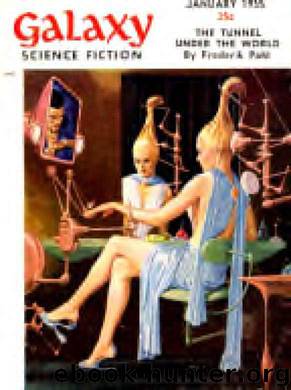Galaxy Magazine (January 1955) by Galaxy

Author:Galaxy
Language: eng
Format: mobi
Published: 1955-01-08T16:00:00+00:00
At a later date, Professor Dimi-tri Mendeleyeff, armed with the latest astronomical figures supplied by Simon Newcomb in Washington, did try to cause a reform, and he and his friends even formed a society for the purpose. But the old ukas stood; it needed the "October Revolution" (which took place on November 7) to bring about a revision. After a short period of investigation—some city Soviets meanwhile wondered whether they should not use the French Revolutionary calendar—the offi-
76
GALAXY SCIENCE FICTION
cial Russian calendar jumped 13 days.
Oh, yes, that French Revolutionary calendar. Nothing ever miscarried so completely in so short a time. And it had not even been conceived by the revolutionary parties!
Though they coined the term "First Year of the Republic," their calendar was ready more than one year preceding the revolution. It bore originally the name of Calendar of Honest Men and its author had been Monsieur Pierre Sylvain Marechal. As a piece of calendar-making, it was feeble indeed. There were 12 months of 30 days apiece, each month subdivided into three decades and five or six holidays, one after every second month, to be named after Honest Men.
The King of France made the tactical error of ordering Monsieur Marshal's almanac seized and burned, thereby calling attention to it. Since it seemed to be—or, better, could be made out to be—an early martyr of the revolution, it was later adopted.
The revolutionary year began on the day declared to be the Birthday of the Republic, "by lucky coincidence, the day of the autumnal equinox, September 22nd, old style." The month beginning on that day was named Vendemiaire (Vintage), followed by Brumaire* (Fog), Fritnaire
(Sleet), Nivose (Snow, beginning Dec. 21st), Pluviose (Rain) and Ventdse (Wind). The first of the spring months was Germinal (Seed, beginning March 21st). Floreal and Prairial (Blossom and Pasture) followed. The three summer months were the last of the year, named, in proper order, Messidor, Thermidor and Fructidor — Harvest, Heat and Fruit.
I am not even certain whether Monsieur Marechal invented all these names himself. They bear much resemblance to the so-called German Peasant's Calendar which is the Gregorian calendar with different names. December, for example, is Yule, January is Hartung (hard month), February is Homung (because animals shed their "horns," i.e., antlers), November is Nebelung (from Nebel, meaning fog, etc.) About half of these names are the same in meaning as those of the French revolutionary calendar. I suspect that French peasants may have used them before they got into print in 1788.
The French revolutionary calendar was actually not used by the revolutionaries. Even their official Moniteur added the Gregorian dates for the sake of clarity. Napoleon threw it out in 1806 to the extreme delight of everybody, friend and foe, and
FOR YOUR INFORMATIO
nothing is left of it but a name on the menu: Lobster Therrrjidor.
A CALENDAR like the Gre-**■ gorian, which will not drift by more than a single day in 3300 years, is a remarkable accomplishment and nobody in his right mind ever suggested doing anything further to its main unit, the year.
Download
This site does not store any files on its server. We only index and link to content provided by other sites. Please contact the content providers to delete copyright contents if any and email us, we'll remove relevant links or contents immediately.
Sita - Warrior of Mithila (Book 2 of the Ram Chandra Series) by Amish(54677)
The Crystal Crypt by Dick Philip K(36775)
Cat's cradle by Kurt Vonnegut(15191)
Always and Forever, Lara Jean by Jenny Han(14808)
Ready Player One by Cline Ernest(14533)
The Last by Hanna Jameson(10152)
Year One by Nora Roberts(9707)
Persepolis Rising by James S. A. Corey(9231)
The remains of the day by Kazuo Ishiguro(8832)
Never let me go by Kazuo Ishiguro(8721)
Red Rising by Pierce Brown(8616)
Dark Space: The Second Trilogy (Books 4-6) (Dark Space Trilogies Book 2) by Jasper T. Scott(8117)
The handmaid's tale by Margaret Atwood(7685)
The Circle by Dave Eggers(7041)
Frank Herbert's Dune Saga Collection: Books 1 - 6 by Frank Herbert(6944)
The Testaments by Margaret Atwood(6777)
Legacy by Ellery Kane(6585)
Pandemic (The Extinction Files Book 1) by A.G. Riddle(6462)
Six Wakes by Mur Lafferty(6158)
